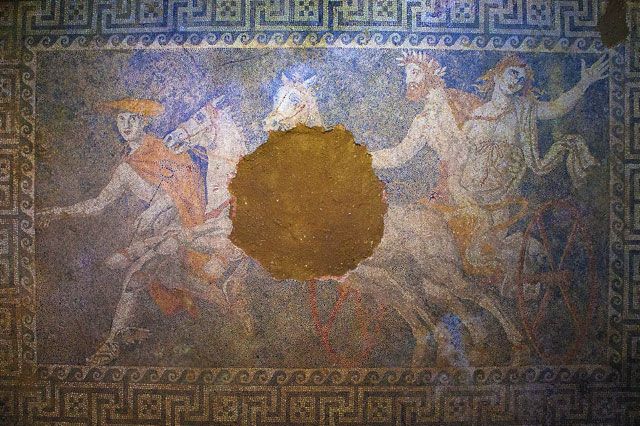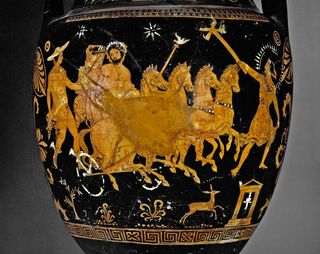Queen of the Underworld's Abduction Revealed in Ancient Greek Mosaic

A newly revealed mosaic on the floor of a vast Greek tomb shows Hades hauling his reluctant bride Persephone to the underworld, archaeologists announced today (Oct. 16).
When the artwork was first uncovered a few days ago, excavators could only see part of the scene. The mosaic seemed to show Hermes, the Greek messenger God and son of Zeus, in a broad-brimmed hat, leading a horsedrawn chariot, with a bearded man in tow. But when more dirt was removed, a third figure came into view: a woman stretching her arm out in distress. Archaeologists with the Greek Ministry of Culture say it's now clear the mosaic depicts a famous scene from Greek mythology: the abduction of Persephone, sometimes called the rape of Persephone.
The mosaic, which is made up of brightly colored pebbles, lies in an antechamber in the huge Kasta Hill burial mound at Amphipolis, an ancient city about 65 miles (104 kilometers) east of Thessaloniki. The ongoing excavation at the site has been watched with great excitement in Greece. [See Photos of the Tomb's Excavation and Mosaic]
Greek archaeologist Katerina Peristeri, who is leading the project, has said the tomb dates back to the fourth century B.C., during the era of the Macedonian leader Alexander the Great. Though Peristeri has been tight-lipped about who she thinks might be buried inside, she told reporters today that, without a doubt, the person must have been "extremely important," according to the Greek Ministry of Culture.
In Greek mythology, Persephone, the daughter of Zeus and the harvest goddess Demeter, was carried off to the underworld by Hades to reign as his queen. (She eventually worked out a deal to split her time between her mother on Earth and her husband in the underworld; the story was used to explain the changing seasons.) The abduction is often depicted in Greek art with Persephone being taken away on Hades' chariot, sometimes accompanied by the messenger god Hermes.

The mosaic at Amphipolis might have a companion. A mural in another royal Macedonian tomb from the fourth century B.C. also shows the abduction of Persephone. That wall painting, in Vergina, was discovered in the 1970s in a tomb that is believed to be the resting place of Philip II, Alexander the Great's father. (However, archaeologists have argued for decades about whom the cremated remains really belong to.)
This is the first time a pebble mosaic has been found in a funerary monument, according to the Greek Ministry of Culture. During the excavations at Kasta Hill, archaeologists have also uncovered a pair of headless sphinxes, two caryatids (columns that take the form of female statues) and traces of paint — but so far, no bones have been found.
Sign up for the Live Science daily newsletter now
Get the world’s most fascinating discoveries delivered straight to your inbox.
Follow Megan Gannon on Twitter and Google+. Follow us @livescience, Facebook & Google+. Original article on Live Science.










